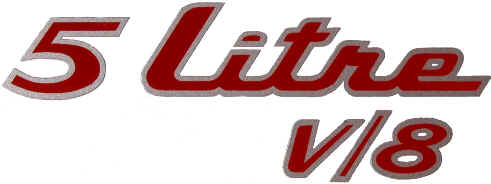Ford And Prodrive Supercharge Australia

When Ford sold Aston Martin to Prodrive, Ford retained a small stake in Aston Martin. But that isn’t the only venture in which Ford and Prodrive work together. Ford Performance Vehicles (FPV) is a joint venture between Ford and Prodrive based in Melbourne Australia. And they’ve just announced a range of supercharged V8 engines. Ford? Prodrive? Australia, home of hoon-mobiles? You have our interest…
Automotive World reports that on the 7th of October FPV will launch the FPV GS and GT model ranges. These cars will be powered by Prodrive developed engines which, according to the article, are “all-new lightweight 5.0 litre supercharged V8 engines producing 315kW (428bhp) and 335kW (455bhp) of power and 545Nm (401.97 lb/ft) and 570Nm (420.41lb/ft) of torque, respectively”. The engines are based on the Coyote Ford Engines introduced to the US in the Mustang.
Bryan Mears, Prodrive’s Asia-Pacific managing director, was very proud of these engines, “The new supercharged V8 engine program represents FPV’s biggest-ever investment in the Australian market, and has been the most extensive and exhaustive development program we’ve ever undertaken. The outcome is phenomenal … these engines are brilliantly responsive, their performance is sensational, and they will take our next generation of FPV models to a level that’s simply unmatched by anyone else.”
Further details of these new engines include a double overhead cam, 32 valves and an all aluminum design. It is also Euro 4 compliant. But although the engine comes in kit form from the United States, Mr Mears was keen to downplay that fact, “It’s important to emphasize just how Australian these engines are. Although the basis of the engine is imported, all the components utilized in the supercharged configuration are locally sourced, and the engines are completely hand-made by the team at FPV in Melbourne.”
In conjunction with this V8 monster, an uprated ZF Sachs automatic gearbox will be mated to it. The gearbox will have a 7-plate clutch pack and 4-planet planetary gear set for higher torque capacity. But don’t fret, a stick will be available.
It is unclear if this powertrain will go stateside. Maybe emission laws will forbid its entry to the United States? But if Alan Mulally is serious about his “One-Ford” policy, he will bring it to America. After all, the next Focus will be a global car, so why can’t this be a global engine?

More by Cammy Corrigan
Latest Car Reviews
Read moreLatest Product Reviews
Read moreRecent Comments
- Dr.Nick What about Infiniti? Some of those cars might be interesting, whereas not much at Nissan interest me other than the Z which is probably big bucks.
- Dave Holzman My '08 Civic (stick, 159k on the clock) is my favorite car that I've ever owned. If I had to choose between the current Civic and Corolla, I'd test drive 'em (with stick), and see how they felt. But I'd be approaching this choice partial to the Civic. I would not want any sort of automatic transmission, or the turbo engine.
- Merc190 I would say Civic Si all the way if it still revved to 8300 rpm with no turbo. But nowadays I would pick the Corolla because I think they have a more clear idea on their respective models identity and mission. I also believe Toyota has a higher standard for quality.
- Dave Holzman I think we're mixing up a few things here. I won't swear to it, but I'd be damned surprised if they were putting fire retardant in the seats of any cars from the '50s, or even the '60s. I can't quite conjure up the new car smell of the '57 Chevy my parents bought on October 17th of that year... but I could do so--vividly--until the last five years or so. I loved that scent, and when I smelled it, I could see the snow on Hollis Street in Cambridge Mass, as one or the other parent got ready to drive me to nursery school, and I could remember staring up at the sky on Christmas Eve, 1957, wondering if I might see Santa Claus flying overhead in his sleigh. No, I don't think the fire retardant on the foam in the seats of 21st (and maybe late 20th) century cars has anything to do with new car smell. (That doesn't mean new car small lacked toxicity--it probably had some.)
- ToolGuy Is this a website or a podcast with homework? You want me to answer the QOTD before I listen to the podcast? Last time I worked on one of our vehicles (2010 RAV4 2.5L L4) was this past week -- replaced the right front passenger window regulator (only problem turned out to be two loose screws, but went ahead and installed the new part), replaced a bulb in the dash, finally ordered new upper dash finishers (non-OEM) because I cracked one of them ~2 years ago.Looked at the mileage (157K) and scratched my head and proactively ordered plugs, coils, PCV valve, air filter and a spare oil filter, plus a new oil filter housing (for the weirdo cartridge-type filter). Those might go in tomorrow. Is this interesting to you? It ain't that interesting to me. 😉The more intriguing part to me, is I have noticed some 'blowby' (but is it) when the oil filler cap is removed which I don't think was there before. But of course I'm old and forgetful. Is it worth doing a compression test? Leakdown test? Perhaps if a guy were already replacing the plugs...


































Comments
Join the conversation
its not the horsepower its the torque 420.41lb/ft starts at 2200 rpm and flat lines all the way to 6000 rpm these moters will be fantastic, god i love australia
Ford didn't sell Aston Martin to Prodrive, but to a consortium headed by Prodrive's chairman David Richards. Interestingly it was Prodrive acquisition of Tickford in 2001 that ultimately gave it an international presents including the FPV (formally Tickford Vehicle Engineering)